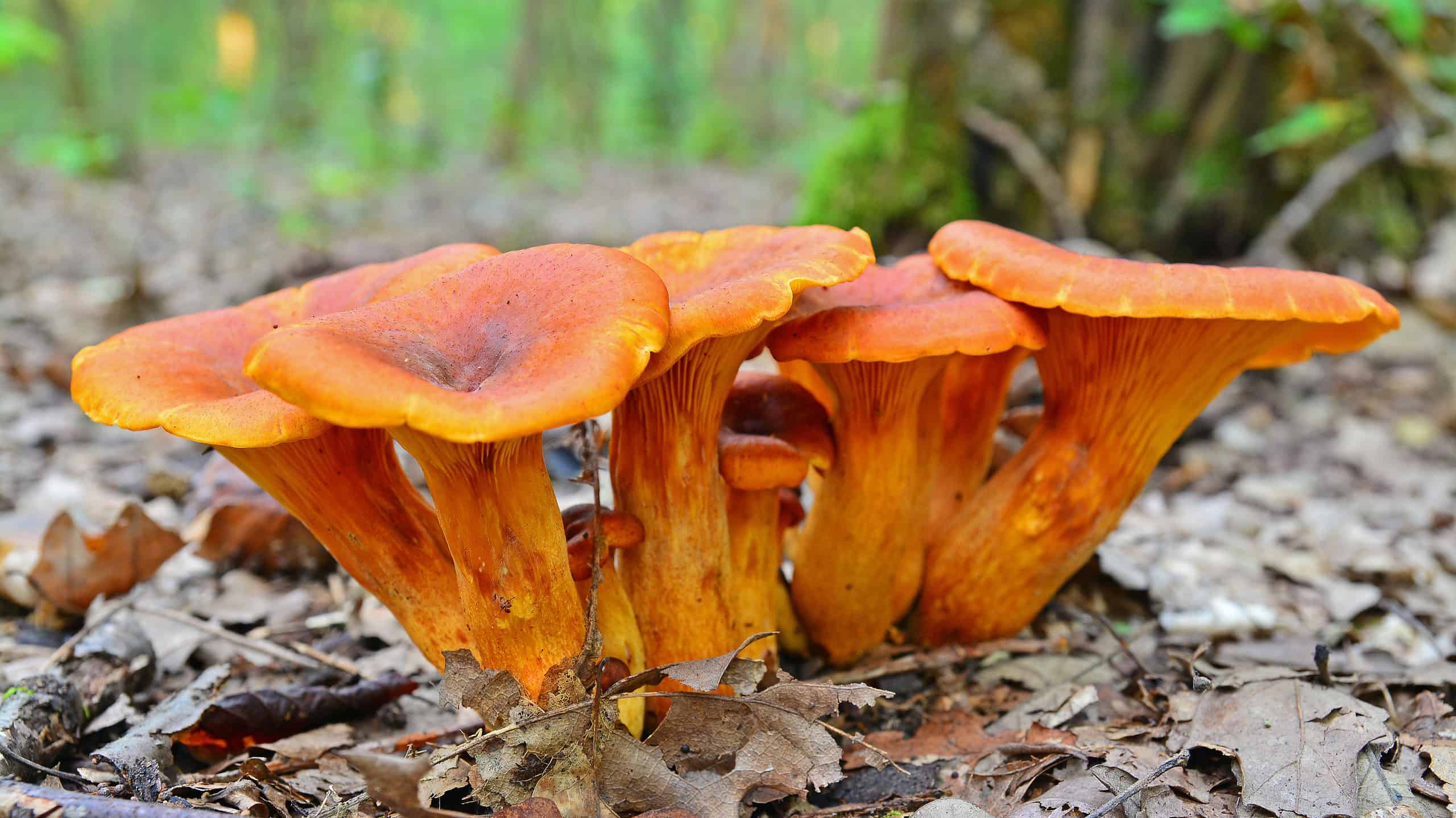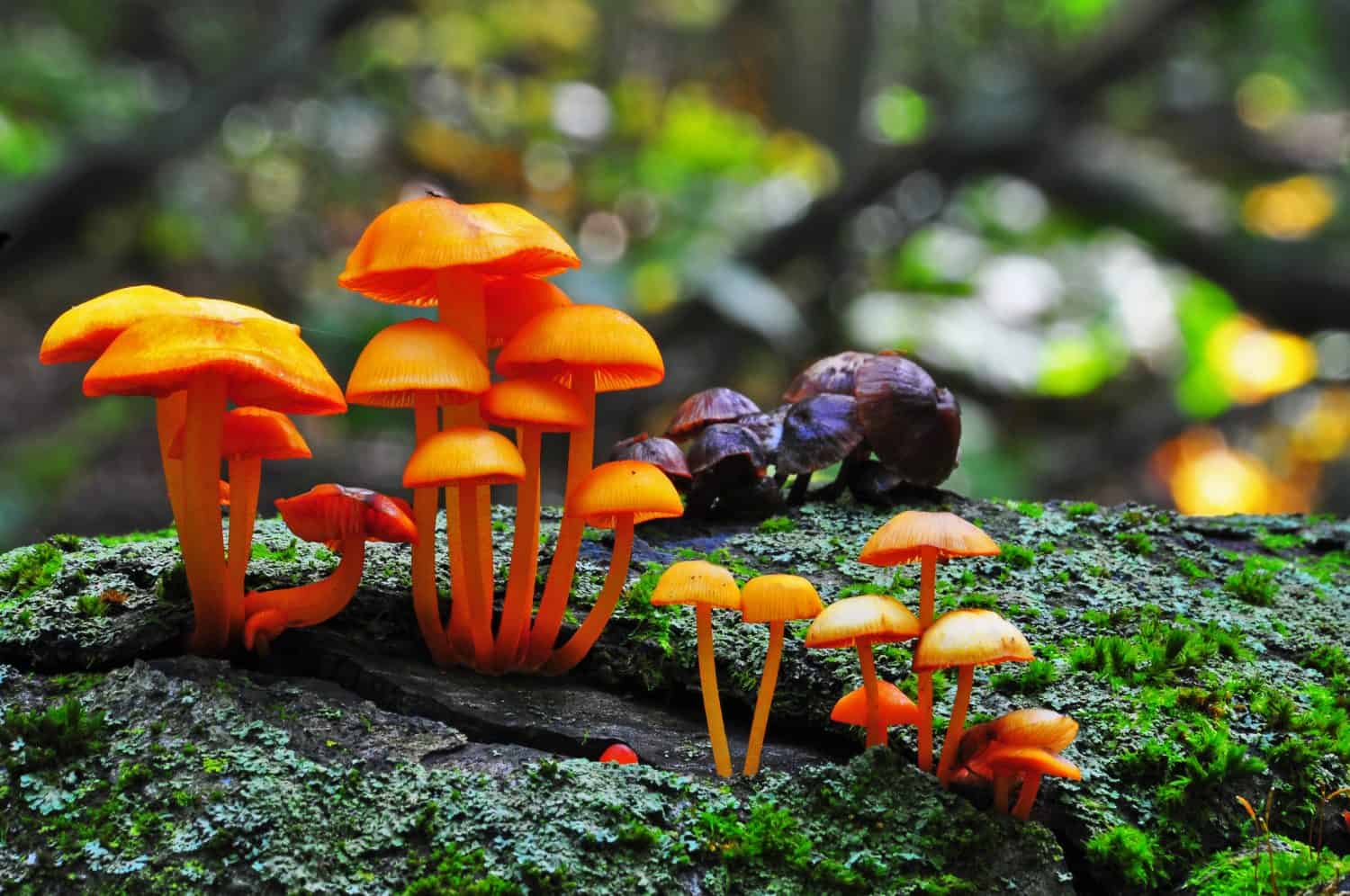Mushrooms come in a variety of colors, shapes, and sizes. Several species of mushroom are a bright, eye-catching orange, and a few of these varieties grow on trees.
Many of these mushrooms are saprobic decomposers, meaning that they grow on dead or dying trees and break down and recycle wood and other forest debris.
Some are also parasitic species that eventually kill the trees they grow on. Let’s dive into four orange mushrooms that grow on trees and how they interact with their environment.
1. Jack-O’-Lantern Mushroom (Omphalotus illudens)
Jack-o’-lantern mushrooms get their name for their bright orange to yellowish orange color. These mushrooms also have sharp-edged gills on their stalks, which sometimes give off a faint greenish glow in the dark, according to the Missouri Department of Conservation.
Despite their striking appearance, jack-o’-lantern mushrooms are poisonous and should never be eaten. Though they are not life-threatening to healthy adults, consuming these mushrooms will cause mild to severe upset stomach. This species appears in North America, east of the Rocky Mountains.
Jack-o’-lantern’s can be mistaken for delicious chanterelle mushrooms. However, while chanterelle mushrooms normally grow singly on the forest floor, jack-o’-lantern mushrooms appear in large clusters on wood — such as at the base of trees, on tree stumps, or on buried wood. Jack-o’-lantern mushrooms appear during the summer and fall.

Clusters of jack-o’-lantern mushrooms grow on wood surfaces, such as on tree stumps.
©bogdan ionescu/Shutterstock.com
2. Chicken of the Woods (Laetiporus sulphureus)
The Laetiporus genus of mushroom is commonly referred to by its nickname, chicken of the woods. In fact, many people describe this edible mushroom as having a similar taste and texture to chicken meat.
Chicken of the woods mushrooms are somewhat common and relatively easy to identify. They are golden yellow or orange in color and create shelf-like overlapping growths on trees. Some species have a yellow pore surface, while others may have a white pore surface. Fresh chicken of the woods also emits a strong, earthy scent.
The fungus grows on both living and dead trees. This species most commonly grows on oaks but other similar species can appear on a number of other trees, including eucalyptus, yew, sweet chestnut, and willow. Unfortunately, chicken of the woods mushrooms are parasitic and eventually kill the host tree. This species makes its home in North America, South America, and Europe.

or chicken of the woods mushroom grows on the side of trees.
©Marc Venema/Shutterstock.com
3. Enokitake Mushrooms (Flammulina velutipes)
Velvet shank mushroom or enoki are 2 other names for Enokitake. In the wild, this fungus grows on the wood of trees — particularly elms. They have brown stems and a yellow to orange cap when exposed to sunlight. Wild enoki mushrooms appear in the spring and fruit throughout the year in Europe and North America but seem to be more commonly found in the colder months.
Enoki mushrooms frequently make their way into Japanese cooking. However, enoki mushrooms that are cultivated for culinary use are small in size, have long delicate stems, and are white in color. Flammulina filiformis is the scientific name for these mushrooms. They are a popular ingredient in soups and stir-fries. Some sources insinuate that they can be eaten raw in salads, but we do not recommend this due to possible Listeria outbreaks. The two species were thought to belong to the same species, but DNA sequencing has shown them to be distinct, according to research from Mycological Progress.

mushrooms grow on the wood of trees, particularly elms.
©Iva Vagnerova/Shutterstock.com
4. Orange Mycena (Mycena leaiana)
Orange mycena are small, sticky mushrooms that grow in dense clusters on deciduous wood. These mushrooms are saprobic decomposers, meaning they get their nutrients from dead or decaying wood, according to the Missouri Department of Conservation.
The cap of a young orange mycena is oval, shiny, and bright reddish orange in color, writes Minnesota Seasons. Over time the mushroom becomes more distinctly bell-shaped or even flat. The color fades to bright orange, then paler and more yellow.
These mushrooms grow in parts of North America, including Mexico, and Central America. A variety of this species also occurs in eastern Australia and New Zealand.
Orange mycena are not toxic to humans. Still, they shouldn’t be eaten and reportedly have no distinctive taste. However, the species may have antibiotic and antitumor properties, making it an important little fungus for humans.

Orange mycena grow on dead or decaying trees.
©Doug Gordon/Shutterstock.com
Summary of 4 Orange Mushrooms That Grow on Trees
| Number | Mushroom | Scientific Name | Edibility | Distribution |
|---|---|---|---|---|
| 1 | Jack-O’-Lantern | Omphalotus illudens | Poisonous | Eastern North America |
| 2 | Chicken of the Woods | Laetiporus sulphureus | Edible, similar taste and texture to chicken meat | North America, South America, and Europe |
| 3 | Enokitake | Flammulina velutipes | Edible, but Flammulina filiformis is the popular choice for consuming | North America, Europe and Asia |
| 4 | Orange Mycena | Mycena leaiana | Not edible | North America, Central America, Australia, and New Zealand |
The photo featured at the top of this post is © nomis_h/Shutterstock.com
The information presented on or through the Website is made available solely for general informational purposes. We do not warrant the accuracy, completeness, or usefulness of this information. Any reliance you place on such information is strictly at your own risk. We disclaim all liability and responsibility arising from any reliance placed on such materials by you or any other visitor to the Website, or by anyone who may be informed of any of its contents. None of the statements or claims on the Website should be taken as medical advice, health advice, or as confirmation that a plant, fungus, or other item is safe for consumption or will provide any health benefits. Anyone considering the health benefits of particular plant, fungus, or other item should first consult with a doctor or other medical professional. The statements made within this Website have not been evaluated by the Food and Drug Administration. These statements are not intended to diagnose, treat, cure or prevent any disease.
Thank you for reading! Have some feedback for us? Contact the AZ Animals editorial team.






